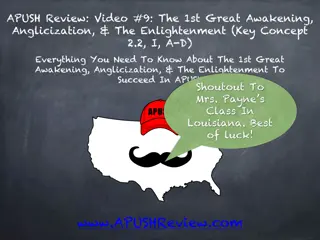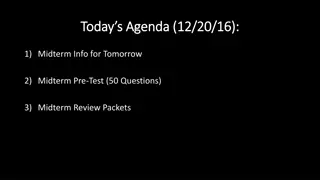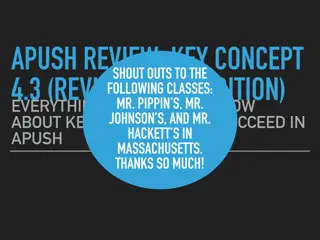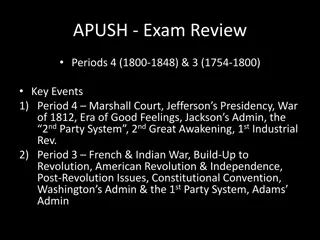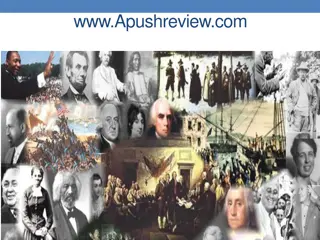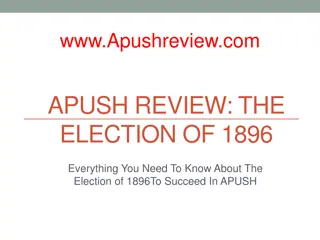
Exploring Key Concept 3.2 in APUSH Curriculum
Discover the impact of new political and societal ideas in the late 18th century as they led to debates, religious fervor, and governmental experiments in the context of the American Revolution. Learn about Enlightenment thinkers, challenges to traditional authority, colonial resistance to taxation, and the influence of key documents like Common Sense and the Declaration of Independence.
Download Presentation

Please find below an Image/Link to download the presentation.
The content on the website is provided AS IS for your information and personal use only. It may not be sold, licensed, or shared on other websites without obtaining consent from the author. If you encounter any issues during the download, it is possible that the publisher has removed the file from their server.
You are allowed to download the files provided on this website for personal or commercial use, subject to the condition that they are used lawfully. All files are the property of their respective owners.
The content on the website is provided AS IS for your information and personal use only. It may not be sold, licensed, or shared on other websites without obtaining consent from the author.
E N D
Presentation Transcript
www.Apushreview.com Period 3: 1754 1800 APUSH REVIEW: KEY APUSH REVIEW: KEY CONCEPT CONCEPT 3.2 3.2 Everything You Need To Know About Key Concept 3.2 To Succeed In APUSH
The New Curriculum Key Concept 3.2 In the late 18th century, new experiments with democratic ideas and republican forms of government, as well as other new religious, economic, and cultural ideas, challenged traditional imperial systems across the Atlantic World. Page 34 of the Curriculum Framework Big ideas: How did Enlightenment ideas help lead to the American Revolution? How was the Constitution able to pass in light of conflicting interests? (North v. South, Federalists v. Anti- Federalists)
Key Concept 3.2, I During the 18th century, new ideas about politics and society led to debates about religion and governance, and ultimately inspired experiments with new government structures. - Page 34 of the Curriculum Framework Protestant evangelical religious fervor (1st Great Awakening) helped promote a new American identity Less of a focus on Anglican Church; 10,000s of colonists converted Appealed to women and younger sons (those that were not given as much land as first-born son) New Lights challenged Old Lights The Enlightenment inspired American political thinkers to emphasize individual talent over hereditary privilege page 34 Similar to the Great Awakening, The Enlightenment challenged traditional authority Jean-Jacques Rousseau: Enlightenment thinker that advocated legal and political equality for all, as well as the end of special privileges for elites After the Revolutionary War, primogeniture was outlawed in many states Eldest son inherits most, if not all, of property
Key Concept 3.2, I Cont. Colonial legislatures allowed for a significant amount of self- governing, which most colonists held dear As Britain began to tax more, colonists resisted these acts They were ok with colonial legislature taxes, NOT Parliament taxes Colonial legislatures were elected by colonists, Parliament was not Thomas Paine s Common Sense: Challenged KG3 it was common sense to break away from the corrupt monarch A little island could not rule a larger continent Declaration of Independence: Inspired by Enlightenment ideas John Locke and Thomas Paine All men had natural rights of Life, liberty, and the pursuit of happiness Articles of Confederation and state constitutions: Feared strong centralized power a la Britain Articles and state constitutions had strong legislative branches Property requirements for voting and citizenship fear of the masses
Key Concept 3.2, II After experiencing the limitations of the Articles of Confederation, American political leaders wrote a new Constitution based on the principles of federalism and separation of powers, crafted a Bill of Rights, and continued their debates about the proper balance between liberty and order. - Page 34 of the Curriculum Framework Challenges under the Articles: Trade: each state could places tariffs on goods from other states discouraged trade between states Finances: each state could coin its own $ - differing values, high inflation in some states, also discouraged trade Many states had debt from Revolutionary War increased taxes Federal government could not require taxes Foreign Relations: Britain refused commercial treaties with US, Congress could not control commerce (sanctions against Britain) Spain cut off access to Mississippi River Both countries supplied Native Americans with weapons Internal unrest: Shays Rebellion: - MA farmers demanded debt relief, attacked court houses These challenges helped many Americans realize a stronger central government was needed ..
Key Concept 3.2, II Cont. Compromises at the Constitutional Convention: Great Compromise (Connecticut Compromise) Roger Sherman Combined VA Plan (large-states) and NJ Plan (small-states) Created a bicameral legislature with one house based on population (House of Reps) and one with equal representation (Senate) A census would be taken every ten years to determine population 3/5 Compromise: For the purpose of representation, 3/5 slaves would count as 1 person in the South BOTH THE GREAT COMPROMISE AND 3/5 COMPROMISE SETTLED THE ISSUE OF REPRESENTATION Limits on federal power under constitution: Federalism division of power between state and federal governments Specific powers for both the federal and state governments Why was the Constitution finally ratified? Federalists (those that favored the constitution) promised to add a Bill of Rights that protected liberties The 1st 10 amendments were added shortly after the Constitution was ratified
Key Concept 3.2, II Cont. Political parties emerged over the following issues: Relationship between national government and states Federalists favored a stronger national government, Democratic-Republicans favored a smaller gov VA and KY Resolutions belief that states could nullify federal laws Economic Policy Hamilton s Financial Plan (Federalists) would strengthen the federal government the creation of the BUS was NOT mentioned in Constitution Hamilton argued the Necessary and Proper, or elastic clause Foreign Affairs Federalists favored Great Britain trade and $, Democratic- Republicans favored France saw French Rev. as an extension of American Rev.
Key Concept 3.2, III While the new governments continued to limit rights of some groups, ideas promoting self-government and personal liberty reverberated around the world. - Page 35 of the Curriculum Framework The push for equality after the Revolutionary War: Some individuals called for the abolition of slavery Pennsylvania s Gradual Abolition Law (1780): Prohibited importation of slaves into PA ALL children born in PA would be free, regardless if their parents were slaves Model for other northern states to follow Increased calls for greater political democracy: Abigail Adams Remember the Ladies Judith Sargent Murray advocated education for females The Constitutional framers postponed a solution to slavery: Since slavery was allowed under the Constitution, it led to conflicts in the 19th century, and ultimately, the Civil War Influence of the American Revolution and Declaration of Independence? Inspired revolutions across the world French Revolution in 1789 Haiti Toussaint L Ouverture helped Haiti gain independence in 1804 Latin America many Spanish colonies gained independence in the early 19th century
Test Tips Multiple-Choice and Short Answer Questions: Issues with the Articles of Confederation Common Sense Constitutional compromises Social impacts of the Rev. War Essay Questions: Issues that led to the creation of political parties
Thanks for watching! Subscribe to my channel Help spread the word Questions? Comments? Leave in comments It s Common Sense to subscribe!




